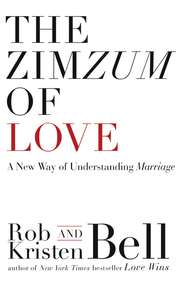По всем вопросам обращайтесь на: info@litportal.ru
(©) 2003-2024.
✖
The Complete Rob Bell: His Seven Bestselling Books, All in One Place
Автор
Год написания книги
2018
Настройки чтения
Размер шрифта
Высота строк
Поля
Numbers.
Deuteronomy.
Memorized.
Remember, the text was central to life for a Jew living in Galilee in Jesus’s day. If you have read the accounts of Jesus’s life, have you ever noticed how everybody seems to know the Bible? Jesus quotes a verse, or a phrase from a verse, and everybody seems to know the text. This is because from an early age Jewish people were taking in the words, and they were becoming a part of them.
This memorization was also necessary because if you lived during that time, you didn’t have your own copy of the text. The printing press wasn’t invented until 1,400 years later. (When you stayed at a hotel in Jesus’s day, the Gideons hadn’t gotten there first.) Probably your entire village could only afford one copy, which would have been kept in the synagogue in a closet called the Torah ark. There is a good chance you would only see the scriptures once a week, and that was when they were brought out of the Torah ark to be read publicly.
Rabbis who taught the Torah were the most respected members of the community. They were the best of the best, the smartest students who knew the text inside and out. Not everybody could be a rabbi.
By age ten, students had begun to sort themselves out. Some would demonstrate natural abilities with the scriptures and distance themselves from the others. These students went on to the next level of education, which was called Bet Talmud (“House of Learning”) and lasted until sometime around the age of fourteen.
Students who didn’t continue their education would continue learning the family trade. If your family made sandals or wine or were farmers, you would apprentice with your parents and extended family as you learned the family trade in anticipation of carrying it on someday and passing it down to the next generation.
Meanwhile, the best of the best, continuing their education in Bet Talmud, would then memorize the rest of the Hebrew scriptures. By age thirteen or fourteen the top students had the entire Bible memorized.
Genesis through Malachi . . . thirty-nine books . . . memorized.
A friend of mine studied in the mid-1980s at a yeshiva (Jewish seminary) in Manhattan. He claims he was the only student in the entire school who didn’t have the entire Old Testament memorized.
Students in this second step of education would also study the art of questions and the oral tradition surrounding the text. For thousands of years, brilliant minds had been discussing the words of God, wrestling with what they meant and what it meant to live them out. This developed into a massive oral tradition. You had a verse, but then you had all the things that had been said about that verse from all of the different people who had discussed it and wrestled with it and commented on it. A mountain of oral tradition. So as a student, you would be learning the text, but you would also be learning who had said what in the name of whom about it.
Now when the rabbi would ask a student a question, he would seldom give an answer. Have you noticed how rarely Jesus answers questions, but how often he responds with another question?
Rabbis had no interest in having the student spit back information just for information’s sake. They wanted to know if the student understood it, if he had wrestled with it. This notion is difficult for the modern mind to grasp because we generally think of education as the transmission of information. The better a student is, the better she is able to produce the right information at the right time.
In the world of rabbinic education, the focus was on questions, which demonstrated that the student not only understood the information but could then take the subject a step further.
By the way, when Jesus’s parents found him in the temple area, how old was he? Twelve. Notice what the text says here: “They found him in the temple courts, sitting among the teachers, listening to them and asking them questions. Everyone who heard him was amazed at his understanding and his answers.”4 (#ulink_fb4513d5-a8db-539d-bbc8-c2d82738db54)
Jesus later says to his disciples, “Remember, everything I learned I passed on to you.”5 (#ulink_89fd8a2f-5eb1-50cc-809c-8517219f3aa6)
Did Jesus go to school and learn like the other Jewish kids his age?
Disciples
Around the age of fourteen or fifteen, at the end of Bet Talmud, only the best of the best of the best were still studying. Most students by now were learning the family business and starting families of their own.
Those remaining would now apply to a well known rabbi to become one of that rabbi’s talmidim (disciples). We often think of a disciple as a student, but being a disciple was far more than just being a student. The goal of a disciple wasn’t just to know what the rabbi knew, but to be just like the rabbi.
This level of education was called Bet Midrash (“House of Study”). A student would present himself to a well known rabbi and say, “Rabbi, I want to become one of your disciples.”
When a student applied to a rabbi to be one his talmidim, he was desiring to take that rabbi’s yoke upon him. He wanted to learn to do what the rabbi did.
So when this student came to the rabbi and said, “I want to follow you,” the rabbi wanted to know a few things: Can this student do what I do? Can this kid spread my yoke? Can this kid be like me? Does this kid have what it takes?
The rabbi would then question the student. Questions about Torah, about tradition, about other rabbis. Questions about the prophets and the sages and the oral law. Questions about interpretation and legislation. Questions about words and phrases and passages.
The rabbi would grill this teenage kid because he wanted to know if this kid could do what he did. The rabbi did not have time to train a kid who wouldn’t ultimately be able to do what he did.
If the rabbi decided that this kid did not have what it took, if this student was not the best of the best, then he would send the student home. He might say, “You obviously love God and know the Torah, but you do not have what it takes to be one of my talmidim.” And then he might add, “Go home and continue learning the family business.”
But if the rabbi believed that this kid did have what it took, he would say, “Come, follow me.”
The student would probably leave his father and mother, leave his synagogue, leave his village and his friends, and devote his life to learning how to do what his rabbi did.6 (#ulink_8d575930-1134-56e6-8087-1ea419567ff9)
He would follow the rabbi everywhere. He would learn to apply the oral and written law to situations. He gave up his whole life to be just like his rabbi.
A friend of mine was in Israel a few years ago and saw a rabbi go into a bathroom and his talmidim followed him. They didn’t want to miss anything the rabbi might say or do.
This kind of devotion is what it means to be a disciple.
One of the earliest sages of the Mishnah, Yose ben Yoezer, said to disciples, “Cover yourself with the dust of [your rabbi’s] feet.”
This idea of being covered in the dust of your rabbi came from something everybody had seen. A rabbi would come to town, and right behind him would be this group of students, doing their best to keep up with the rabbi as he went about teaching his yoke from one place to another. By the end of a day of walking in the dirt directly behind their rabbi, the students would have the dust from his feet all over them.
And that was a good thing.
So at the age of thirty, when a rabbi generally began his public teaching and training of disciples, we find Jesus walking along the Sea of Galilee.7 (#ulink_d4fb8cc5-83db-5fdd-9f93-9606acb1c9c0)
“He saw two brothers, Simon called Peter and his brother Andrew. They were casting a net into the lake, for they were fishermen.”
Why are they fishermen?
Because they aren’t disciples. They weren’t good enough; they didn’t make the cut.
Jesus calls the not-good-enoughs.
The story continues: “At once they left their nets and followed him.”
This is strange, isn’t it? Why do they just drop their nets? Why would they quit their jobs for some rabbi they had never met? And those Christian movies don’t help. Jesus is usually wearing a white bathrobe with a light blue beauty pageant sash, and his hair is blow-dried and his eyes are glazed over . . .
and he’s Swedish.
But given the first century context, it’s clear what is going on here. Can you imagine what this must have been like—to have a rabbi say, “Come, follow me”?
To have a rabbi say, “You can be like me”?
Of course you would drop your net. The rabbi believes you can do what he does. He thinks you can be like him.
Jesus then comes upon James and John, who are fishing with their father, Zebedee. They are apprentices, learning the family business, which in this case happens to be fishing.
If they are still with their father, then how old are they? Fourteen, fifteen, sixteen? Twenty?
Jesus took some boys who didn’t make the cut and changed the course of human history.
Now being a disciple was terrifying and exhilarating and demanding—they never knew what the rabbi would do next. One account in the book of Matthew says that Jesus was talking to his disciples at Caesarea Philippi. This is one of those details that is easy to skip, but it is significant. Caesarea Philippi was the world center of the goat god, Pan. People came from all over the world to worship this god. There is a cliff with a giant crack in it that the followers of Pan believed was the place where the spirits from hell would come and go from the earth. The crack was called the Gates of Hell. They built a temple for Pan there and then a court next to it where people would engage in sexual acts with goats during the Pan worship festivals.8 (#ulink_aa23a814-309b-534b-9115-1c567612e0b4)











